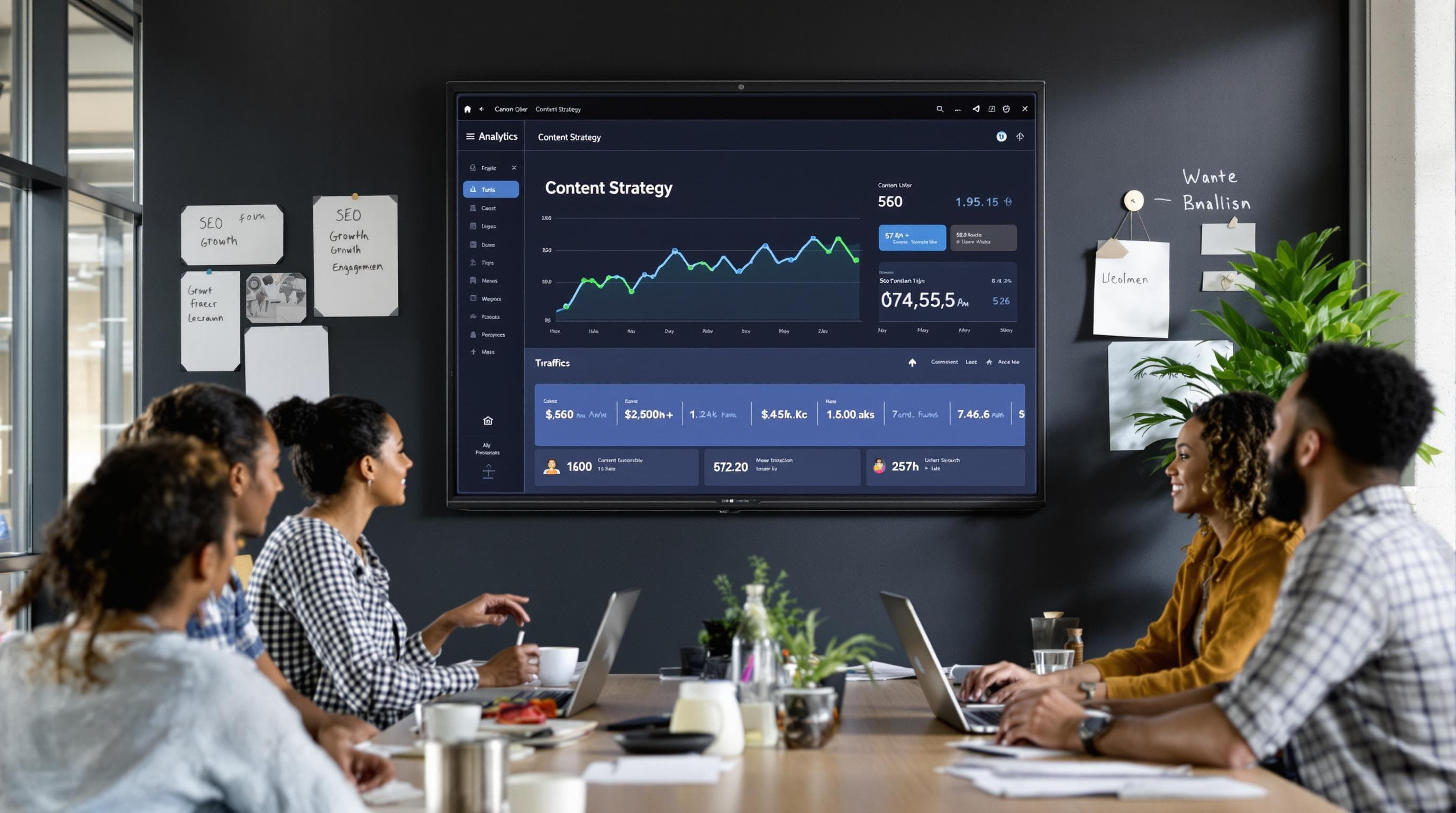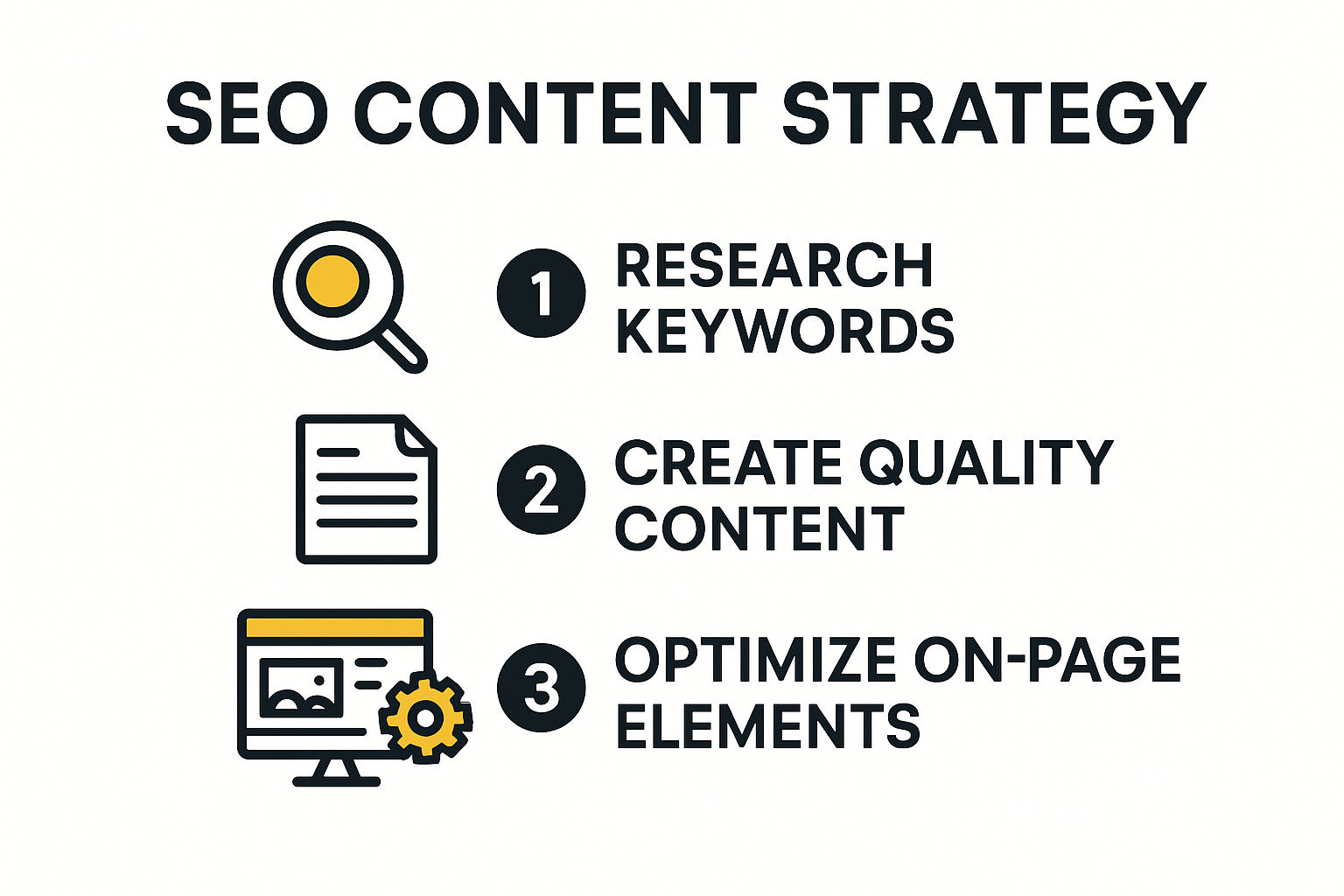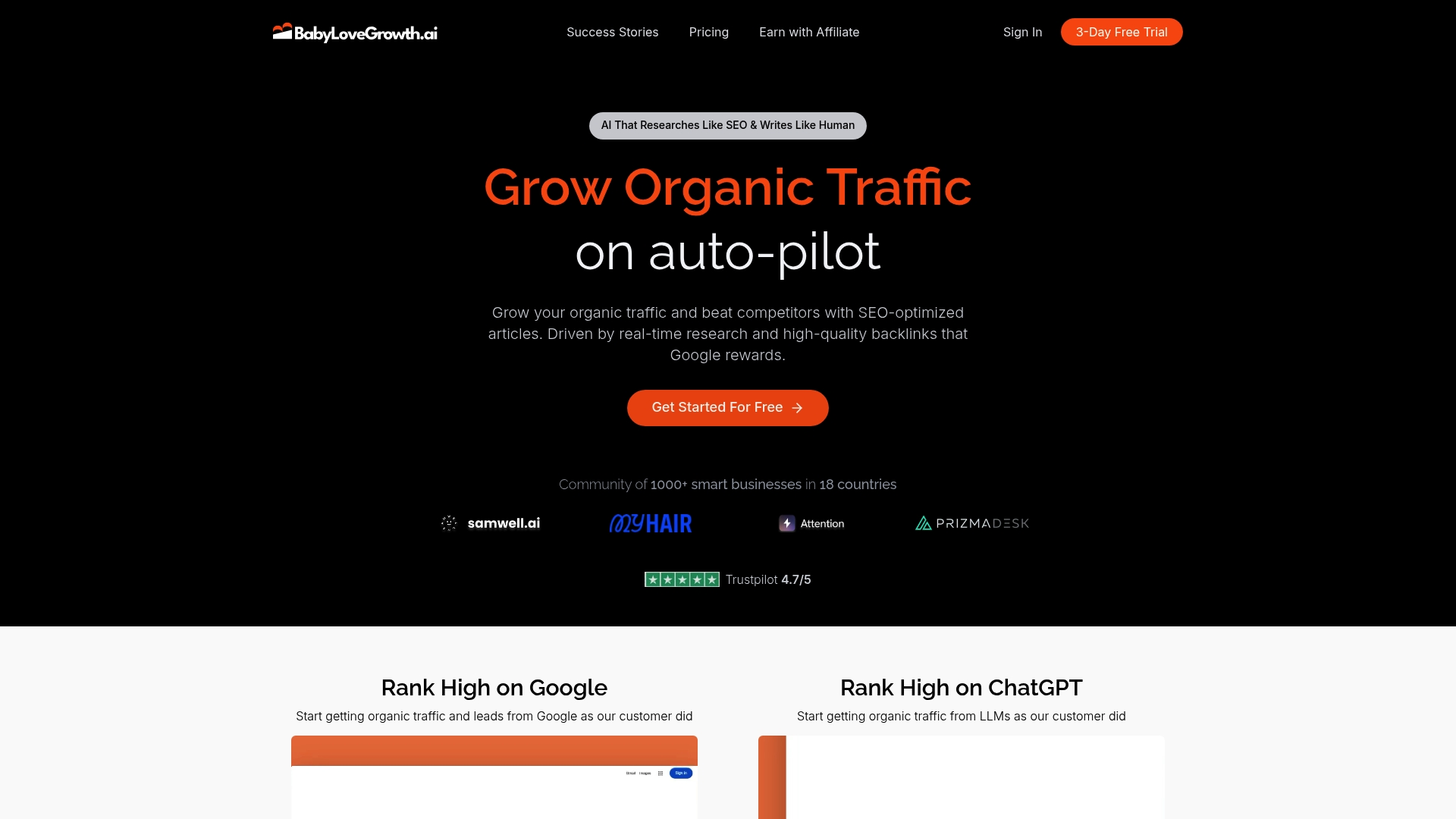SEO Content Strategy for 2025: A Guide for Business Success


SEO content strategy is steering business wins in 2025, and companies that do it right are seeing massive payoffs. Get this. Brands with robust content strategies see up to 3 times more organic traffic than competitors who wing it. Most teams think simply churning out more articles will land them at the top of Google, but that mindset is missing the real edge. The smartest marketers are uncovering hidden gaps and building focused content ecosystems that drive results regular blog posts can never match.
Table of Contents
- What Is An SEO Content Strategy And Why It Matters
- Steps To Build Your SEO Content Strategy In 2025
- Best Practices To Optimize And Measure Content Performance
- Common Mistakes To Avoid With Your SEO Content Strategy
Quick Summary
| Takeaway | Explanation |
|---|---|
| Comprehensive Content Gap Analysis | Conducting a thorough evaluation of existing content against competitors helps identify unexplored topics, enhancing topical authority and audience engagement. |
| Building Topical Authority | Establish interconnected content ecosystems by developing pillar pages and supporting cluster content, leveraging internal linking to signal expertise to search engines. |
| Focus on User Search Intent | Align content with what users are genuinely searching for by providing detailed answers and avoiding superficial or irrelevant content, improving overall search rankings. |
| Technical Optimization is Crucial | Implement clear page elements such as precise metadata and structured headings while ensuring mobile responsiveness to meet search engine requirements. |
| Balanced Metrics Monitoring | Avoid focusing excessively on engagement metrics like click-through rates; instead, prioritize genuine value and user satisfaction to support long-term success. |

What Is an SEO Content Strategy and Why It Matters
An SEO content strategy represents a systematic approach to creating, organizing, and optimizing digital content that attracts and engages target audiences while simultaneously meeting search engine ranking requirements. At its core, this strategy connects the art of compelling storytelling with the science of search engine optimization.
The Fundamental Components of SEO Content Strategy
SEO content strategy goes beyond simply producing random articles or blog posts. Research published in the Journal of Digital Marketing Research reveals that successful strategies involve a comprehensive framework targeting precise audience needs while aligning with search algorithm preferences.
The key components include:
- Keyword Research: Identifying precise search terms your target audience uses
- Content Planning: Developing a structured approach to content creation
- Technical Optimization: Ensuring content meets search engine technical requirements
To help clarify the core building blocks of a successful SEO content strategy, the following table summarizes the main fundamental components and their key focus:
| Component | Key Focus |
|---|---|
| Keyword Research | Finding relevant search terms used by the target audience |
| Content Planning | Structuring and scheduling content creation efforts |
| Technical Optimization | Meeting technical requirements for better search performance |
Strategic Importance in Digital Marketing
Research from the International Journal of Online Marketing underscores that a well-defined SEO content strategy directly influences a brand's digital marketplace competitiveness. Businesses implementing strategic content approaches experience significant advantages in online visibility and audience engagement.The strategy serves multiple critical functions:
- Improves organic search rankings
- Attracts high-quality website traffic
- Establishes brand authority and credibility
- Creates sustainable long-term digital marketing results
Successful SEO content strategies recognize that modern search algorithms prioritize user experience and genuine value over keyword stuffing or manipulative tactics. This means creating content that genuinely answers user questions, provides actionable insights, and demonstrates expertise within a specific domain.
By developing a nuanced understanding of target audience search behaviors and consistently delivering high-quality, relevant content, businesses can transform their digital presence from passive online entities to active, engaging platforms that consistently attract and retain audience attention.
The ultimate goal of an SEO content strategy is not just visibility but meaningful connection - transforming search engine interactions into genuine audience engagement and potential business opportunities.
Steps to Build Your SEO Content Strategy in 2025
Building an effective SEO content strategy in 2025 requires a sophisticated approach that goes beyond traditional keyword targeting. Modern strategies demand a holistic understanding of audience needs, technological capabilities, and search engine complexities.
Comprehensive Content Gap Analysis
Search Engine Land research highlights the critical importance of conducting a thorough content gap analysis. This process involves systematically evaluating your existing content against competitors and identifying unexplored topics that can enhance your website's topical authority.The content gap analysis process includes:
- Competitive Content Mapping: Identifying topics your competitors cover that you have not
- Audience Search Intent Research: Understanding the specific questions and needs your target audience seeks to address
- Topical Coverage Evaluation: Assessing the depth and comprehensiveness of your current content offerings
To outline the steps in conducting a content gap analysis, here's a process table summarizing the key actions and goals:
| Step | Description | Goal |
|---|---|---|
| Competitive Content Mapping | Compare your topics with competitors' coverage | Uncover missed/unexplored topics |
| Audience Search Intent Research | Identify target audience questions and needs | Align content with actual user intent |
| Topical Coverage Evaluation | Assess depth and range of current content | Ensure comprehensive topic coverage |
Building Topical Authority

Key strategies for building topical authority include:
- Develop comprehensive pillar pages that provide in-depth coverage of core topics
- Create supporting cluster content that explores specific subtopics in detail
- Implement strategic internal linking to demonstrate content relationships
- Ensure consistent quality and depth across all related content pieces
The most successful SEO content strategies in 2025 will leverage advanced technologies and insights to create more targeted, valuable content. This means moving beyond simple keyword optimization to understanding complex user intent, addressing specific audience pain points, and delivering genuinely helpful information.
Technological advancements like AI-powered content analysis and natural language processing will play a crucial role in refining content strategies. These tools can help identify nuanced content opportunities, predict emerging search trends, and optimize content more precisely than ever before.
Successful implementation requires a dynamic approach. SEO content strategies must remain flexible, continuously adapting to changing search algorithms, emerging technologies, and shifting user behaviors. Regular content audits, performance tracking, and strategic refinements will be essential to maintaining competitive digital presence.
Ultimately, the goal is not just to rank higher in search results but to provide genuine value to your target audience. By focusing on creating comprehensive, authoritative, and truly helpful content, businesses can build trust, establish thought leadership, and drive meaningful engagement in the increasingly competitive digital marketplace.
Best Practices to Optimize and Measure Content Performance
Optimizing and measuring content performance requires a strategic approach that goes beyond traditional metrics. In 2025, successful digital strategies demand sophisticated tracking and continuous improvement techniques that provide actionable insights into content effectiveness.
Technical Optimization Fundamentals
Energy.gov research on search engine optimization emphasizes the critical importance of creating clear, descriptive page elements that communicate content purpose effectively. This includes developing unique page titles, structured headings, and concise meta descriptions that accurately represent the content.Key technical optimization strategies include:
- Precise Metadata: Crafting compelling titles and descriptions that accurately represent content
- Header Structure: Implementing hierarchical heading tags (H1-H3) for clear content organization
- Mobile Responsiveness: Ensuring content displays seamlessly across all device types
Performance Measurement and Analytics
Research from Educause highlights the significance of regularly updating content and tracking performance metrics. Modern content strategies require a comprehensive approach to measuring success that goes beyond simple traffic numbers.Advanced performance measurement techniques include:
- Tracking user engagement metrics (time on page, bounce rate)
- Analyzing conversion rates and goal completions
- Monitoring organic search rankings and visibility
- Evaluating content quality through user interaction signals
Successful content optimization in 2025 demands a holistic approach that combines technical precision with deep audience understanding. This means leveraging advanced analytics tools to gain nuanced insights into how users interact with your content.
AI-powered analytics platforms will play an increasingly important role in content performance measurement. These tools can provide granular insights into user behavior, content effectiveness, and potential improvement areas that traditional analytics might miss.
Content creators must adopt a continuous improvement mindset. This involves regular content audits, performance reviews, and strategic refinements based on data-driven insights. The most successful strategies will be those that can quickly adapt to changing user preferences and search engine algorithms.
Ultimately, the goal of content optimization is not just to improve search rankings but to create genuinely valuable experiences for your target audience. By focusing on delivering high-quality, relevant content and continuously measuring its performance, businesses can build stronger connections with their audience and achieve sustainable digital growth.
Common Mistakes to Avoid With Your SEO Content Strategy
Navigating the complex world of SEO content strategy requires awareness of potential pitfalls that can undermine your digital marketing efforts. Understanding and avoiding common mistakes can significantly improve your content's performance and search engine visibility.
Misalignment with User Search Intent
Research from the Content Marketing Institute reveals that neglecting user search intent is a critical error in content strategy. When content fails to address the specific questions and needs users are searching for, it results in high bounce rates and diminished search engine rankings.Common search intent misalignment mistakes include:
- Superficial Content: Creating shallow articles that do not deeply address user questions
- Keyword Stuffing: Forcing keywords without providing genuine value
- Irrelevant Information: Including content that does not directly answer user queries
Metric Misinterpretation and Engagement Traps
Academic research from ArXiv warns about the dangers of overemphasizing engagement metrics. Creators often fall into the trap of prioritizing clickbait strategies that generate short-term engagement but fail to deliver substantive value.Key engagement metric mistakes to avoid:
- Focusing solely on click-through rates
- Prioritizing quantity over content quality
- Generating sensationalist headlines that do not reflect actual content
- Neglecting long-term user satisfaction
Successful SEO content strategies require a balanced approach that goes beyond surface-level metrics. This means creating content that genuinely serves user needs while maintaining technical SEO best practices.
Another significant mistake is inconsistent content production. Sporadic publishing schedules and irregular content quality can harm your website's credibility and search engine performance. Developing a consistent, reliable content pipeline is crucial for maintaining audience trust and search engine rankings.
Technical SEO oversights can also derail content strategies. These include neglecting mobile optimization, ignoring page load speeds, and failing to implement proper schema markup. Modern search algorithms prioritize user experience, so technical performance is as important as content quality.
Content creators must also avoid the temptation of copying or duplicating content. Search engines penalize websites with unoriginal or plagiarized material. Each piece of content should offer unique insights, perspectives, or information that distinguishes it from existing resources.
Building a robust SEO content strategy requires continuous learning and adaptation. Regularly audit your content, stay updated on search engine algorithm changes, and be willing to pivot your approach based on performance data and emerging trends.
Ultimately, the most effective SEO content strategies prioritize user value above all else. By focusing on creating genuinely helpful, well-researched, and expertly crafted content, businesses can overcome common mistakes and build a strong, sustainable digital presence.
Frequently Asked Questions
What is an SEO content strategy?
An SEO content strategy is a systematic approach to creating, organizing, and optimizing digital content to attract and engage target audiences while meeting search engine ranking requirements.
Why is a content gap analysis important for SEO in 2025?
A content gap analysis helps identify unexplored topics and areas where your competitors have a stronger presence, allowing you to enhance your website's topical authority and improve audience engagement.
How can I build topical authority with my SEO content strategy?
You can build topical authority by creating comprehensive pillar pages, producing related cluster content, and implementing strategic internal linking to signal expertise and relationships between content topics to search engines.
What common mistakes should I avoid in my SEO content strategy?
Avoid misalignment with user search intent, focusing excessively on engagement metrics like click-through rates, and inconsistencies in content production. Prioritize creating valuable content that genuinely serves user needs.
Ready to Close Content Gaps and Achieve Sustainable SEO Growth?
Struggling to keep up with evolving SEO demands is frustrating, especially when your manual content creation falls short or your team wastes time guessing at topical authority. This article highlights how businesses are missing real organic growth because they lack integrated content gap analysis, AI-driven research, and automated optimization that connects with what users actually need. If you want results that match the best-performing brands and stop falling behind your competitors, it is time to transform your SEO approach.

Give your business an unfair advantage with Babylovegrowth.ai. Instantly automate SEO-optimized article creation, uncover gaps in your topical coverage, and deploy tailored 30-day content plans backed by real-time research and strong backlink strategies. Discover how easy it is to reach higher Google and ChatGPT rankings with our AI-driven platform. Explore our platform now and see proven examples of smarter SEO content strategies in action. Don’t wait—secure your organic growth in 2025 today.
Recommended
- BabyLoveGrowth | The #1 Ranked AI Writer for SEO
- BabyLoveGrowth | The #1 Ranked AI Writer for SEO
- BabyLoveGrowth: Keyword Gap Analysis Tool
- BabyLoveGrowth | The #1 Ranked AI Writer for SEO
- The Ultimate Guide to SEO in 2025: How to Dominate in the Age of AI | 12AM Agency
- Top 10 SEO Strategies to Boost Organic Traffic in 2024 - Digital PR Expert | Digital Marketing & Search Leaders
Smart SEO,
Faster Growth!
Most Read Articles

Generative Engine Optimization (GEO)
Learn how Generative Engine Optimization (GEO) helps your content rank in AI search engines like ChatGPT and Google AI. This comprehensive guide explains the differences between SEO and GEO, why it matters for your business, and practical steps to implement GEO strategies for better visibility in AI-generated responses.

Track LLM Traffic in Google Analytics 4 (GA4)
Learn how to track and analyze traffic from AI sources like ChatGPT, Claude, Perplexity, and Google Gemini in Google Analytics 4. This step-by-step guide shows you how to set up custom filters to monitor AI-driven traffic and make data-driven decisions for your content strategy.

How to Humanize AI Text with Instructions
Learn practical techniques to make AI-generated content sound more natural and human. This guide covers active voice, direct addressing, concise writing, and other proven strategies to transform robotic text into engaging content.

Open AI Revenue and Statistics (2024)
Comprehensive analysis of OpenAI financial performance, user engagement, and market position in 2023. Discover key statistics including $20B valuation, $1B projected revenue, and 100M+ monthly active users.